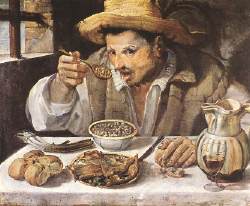|
|
|
CARRACCI,
Annibale/ ARTISTS BEFORE 1650/ ART MAIN
home
|
|
(b. 1560, Bologna, d. 1609,
Roma)
|
|
film and food
|
|
Carracci. Family of
Bolognese painters, the brothers Agostino (1557-1602) and Annibale
(1560-1609) and their cousin Lodovico (1555-1619), who were prominent
figures at the end of the 16th century in the movement against the
prevailing Mannerist artificiality of Italian painting.
They worked together
early in their careers, and it is not easy to distinguish their shares
in, for example, the cycle of frescos in the Palazzo Fava in Bologna
(c.1583-84). In the early 1580s they opened a private teaching academy,
which soon became a centre for progressive art. It was originally called
the Accademia dei Desiderosi (‘Desiderosi’ meaning ‘desirous of fame and
learning’), but later changed its name to Academia degli Incamminati
(Academy of the Progressives). In their teaching they laid special
emphasis on drawing from the life (all three were outstanding graphic
artists) and clear draughtsmanship became a quality particularly
associated with artists of the Bolognese School, notably Domenichino and
Reni, two of the leading members of the following generation who trained
with the Carracci.
|
literature and food
|
|
music and food
|
|
photography and food |
|
Italian influence on French
cuisine
|
|
Italian
wine
|
 |
|
Hunger as Divine: Dante’s Divine Comedy |
|
Annibale Carracci, the Farnese Palace, Rome: The Farnese Palace, Rome (Great Fresco Cycles of the Renaissance)
–amazon.de |
Butcher’s Shop
1580s
Oil on canvas, 185 x 266 cm
Christ Church Picture Gallery, Oxford
|
|
Food on the Floor:
Edible Imagery in Roman Dining Room Floor Mosaics |
|
Using the language of the
Bible, theologians have referred to the dangers of the consumer habits
which emanate from such abundant supply of products as ‘temptations of
the flesh,’ and these are quite often the theme of rather graphic
paintings of butchers’ shops. Like Aertsen and Beuckelaer’s art, in the
16th century they are not yet pure still-lifes, although they do display
the tendency towards materialization inherent in this genre.
In Annibale Carracci’s
painting with this motif, the characters are facing the viewer as if
they were on stage. On the right a butcher’s servant is dragging along a
freshly cut ox or cow, the spine and innards visible as in an anatomical
longitudinal section, which he is about to hang on a hook. Another
servant is kneeling beside a sheep that is lying on the ground, its legs
tied, which he is about to slaughter. A third servant is holding a pair
of scales, adjusting its weights. In the background, a butcher is taking
a hook off the ceiling. Goods are exhibited in front of him, and an old
woman is seen stealing a piece of meat without being noticed by the
butcher. On the left a rather foolish-looking man, dressed in a
dandy-like manner with a feathered hat, tattered, baggy yellow trousers
and a huge codpiece, can be seen rummaging awkwardly in his purse. The
actions of the characters show that the painting is a thematic
representation of a literary motif from a picaresque
tale. |
|
|
|
|
|
|
Italian food
From Raphael to Carracci: The Art of Papal Rome
– amazon usa
artists before 1650 bookshop (UK) |
Fishing
before 1595
Oil on canvas, 136 x 253 cm
Musée du Louvre, Paris
|
|
|
|
This painting and its companion piece, The
Hunting was executed by Carracci in his period in Bologna. At this time
he was extremely interested in landscape, and his experiments are a
foreshadowing of Poussin’s classical compositions; but in these pictures
he is exploring in a different direction, in the tradition of Bassani,
whose studios continued to turn out landscapes which were prized all
over Europe.
This painting and its companion piece, The Hunting was executed by
Carracci in his period in Bologna.
|
|
|
 |
|
|
The Beaneater
1580-90
Oil on canvas, 57 x 68 cm
Galleria Colonna, Rome
|
|
|
|